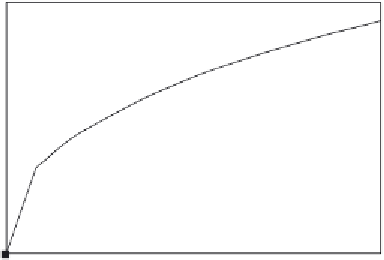Biomedical Engineering Reference
In-Depth Information
6
5
4
3
2
1
0
0
1
2
3
4
5
6
Time (min)
Figure 6.12
Binding of CA antigen in solution to the anti-CA immobilized on the
SPR sensor chip.
coefficient increase. This is in accord with the results presented in the different chapters
throughout the topic wherein, generally, increases in the fractal dimension lead to increases
in the binding rate coefficient. This is for the same analyte-receptor system. Here an
attempt is made to compare the binding of the same analyte (albeit not quite the same,
but cancer in general) to different types of biosensor systems. The intent is to provide fresh
physical insights into the binding of cancer and other analytes to different biosensor sys-
tems so that a better understanding of the interactions occurring on the different surfaces
may be obtained, leading to a better control and management of these interactions in
desired directions.
6.5 Conclusions
A fractal analysis is presented for the binding and dissociation (if applicable) of the same
analyte to different biosensor surfaces. The examples are analyzed in such a manner as to
provide fresh physical insights into these types of analyte-receptor interactions occurring
on biosensor surfaces. The intent of the analysis was to provide a fresh and new avenue by
which a better understanding of these analyte-receptor interactions selected as model
reactions would help pave the way to promote a clearer and better understanding of these
reactions occurring on surfaces, in general.
The five sets of reactions selected at random from the literature include:
(1) The amperometric detection of
E. coli
using electropolymerization and coating of GCEs
with pyrrole amine (Pyy-NH
2
)(
Abu-Rabesh et al., 2009
), and the real-time PCR ampli-
fication of aptamers for the detection of
E. coli
(
Lee et al., 2009
).



































